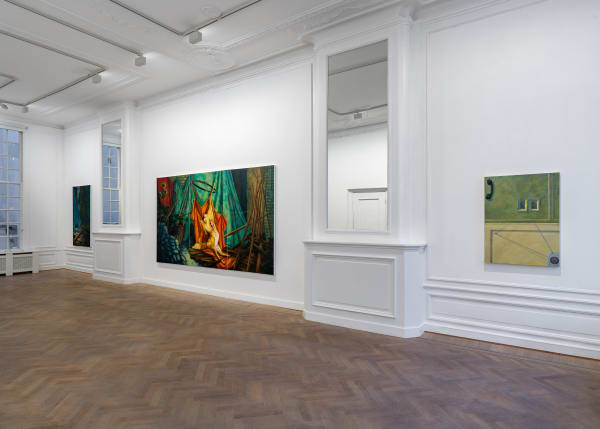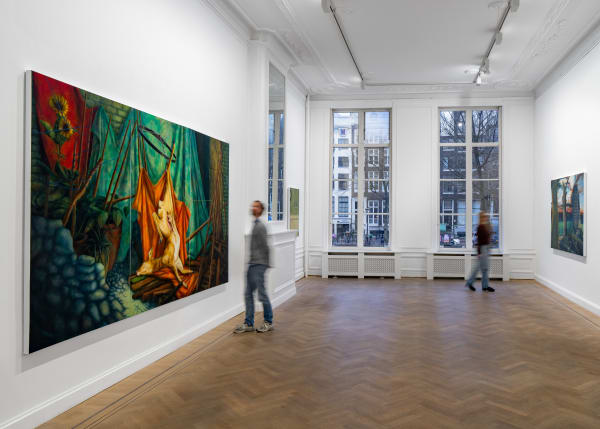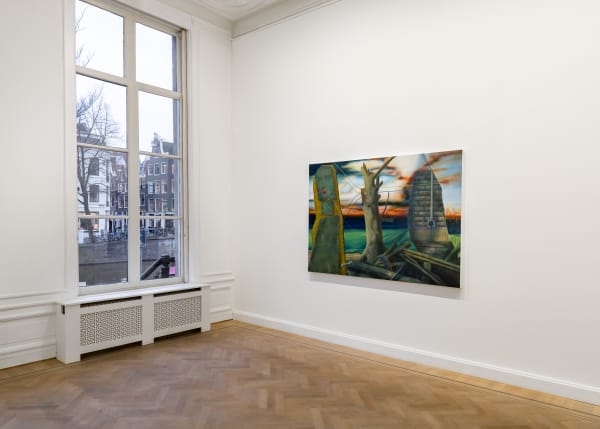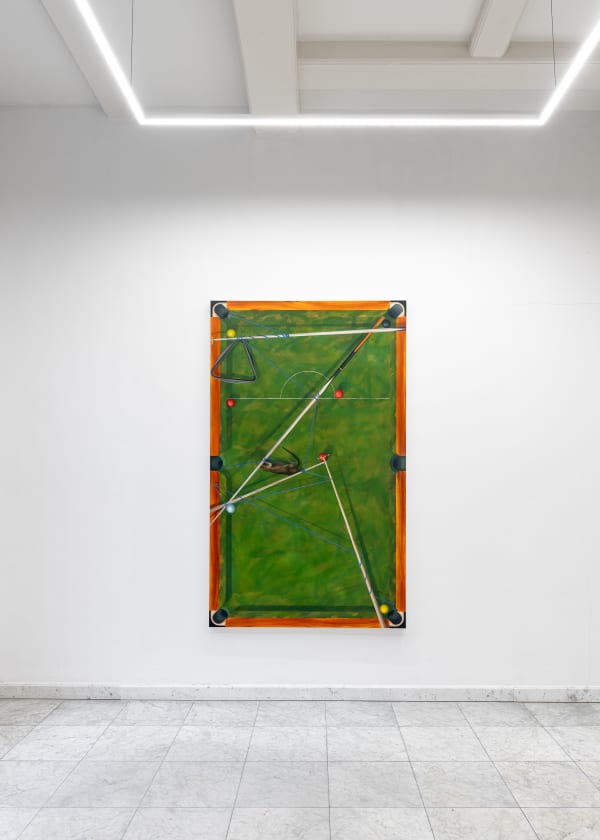Tommy Harrison: Double Bind
GRIMM is pleased to announce a solo exhibition with new works by Tommy Harrison (b. 1996, Stockport, UK). This will be the second solo exhibition of the artist with the gallery, following Tone Cluster at GRIMM, New York, NY (US) in 2023.
Double Bind represents a homecoming of sorts for Harrison. Having trained in the English Midlands as a landscape architect, a skill set we can identify in his geometrical and well-organised arrangements of space, Harrison moved to Amsterdam to take up a position in an architecture practice. Still a year before he became an artist, Harrison would wander around the city, which he found hauntingly lit by iridescent streetlamps beside the canals. He found refuge in public museums, especially among the repository of Dutch Golden Age masterpieces – still lives, especially – in the Rijksmuseum and the Stedelijk Museum’s collection of Parisian Expressionism. The painting that had the greatest impact on him was Chaïm Soutine’s Le Boeuf (c. 1925), one of a series of nine canvases by the Belarusian-Jewish artist that depict mercury sulphide-red flesh and suet flayed and opened up for us to peer inside. Something of Soutine’s abattoir scenes can be traced to the works on show here.
Harrison’s paintings are often fleshy and sometimes gory, pointing toward what happens to life after death. Harrison never flinches from getting up close to his subject, whether right in front of him or from the annals of art history; he sniffs and understands exactly what it is, before transforming his subjects from the contexts that we habitually use to make sense of them. 'The fact of the object, whether it is a deer, a cistern or a light socket’, Harrison has said, ‘make demands on me as an artist.’ His compositions make demands on us, too. In this way, the title of this exhibition, Double Bind, when we are confronted by two irreconcilable demands or choices, feels apropos. Harrison’s paintings hold us in a vice-like grip, a double bind between the real and the surreal, the commonplace and the profound, and between life and death itself.
In Harrison's triptych Web (2023), for instance, the composition of the slaughtered deer, held up by one of its hooves, its abdomen sliced open and neck crumpled on the table, is lifted from a 1612 Frans Snyders painting held at the Muzeum Sztuki w Łodzi in Poland. In Harrison’s rendering, the deer is not found among the objects of memento mori as in the classical Dutch still life, but placed among plant pots, dry-stone walls, and piled-up sticks that are arranged as though a stake to burn witches. Many of the new paintings are sites of imminent or recent destruction, constructing landscapes inspired by his industrial studio interior but now desecrated into piles of debris and tinder. Amongst the rubble, hands direct us like disembodied saints, not trapped under the ruination but rather guiding the way beyond the grave.
Still a young yet prodigious painter, Harrison only came to his vocation in the years after Amsterdam when, like Titian, he draped cloths over chairs and meticulously painted their folds, creases, and furrows. He is already a master organiser of paint. Like the architect, Harrison disassembles his compositions into quarters, thirds, and halves with a remarkable sense of depth; many paintings manage to assume a frontal perspective that makes Fra Angelico seem askew. But like a necromancer, Harrison can conjure the unexpected and impossible – the ostensibly dead – into the banal world of life right in front of us. Above all, Harrison is a rigorous colourist, a Colour Field painter in the age of perfect digital colour matching, who has described himself as a ‘formalist abstract painter trapped in the body of a figurative realist.’
Harrison is part of an evolving and close-knit group of contemporary painters based in Britain, who have taken up the genre of the hyper-realist painting and reframed it through the magnifying glass of the strange, the disconcerting, and the incongruous. It is therefore not by coincidence that Harrison features a broken-up portrait of the novelist Franz Kafka, who looms largest in these canvases, and quite literally in the fragmentary potpourri of the painting Double Bind (2023). Kafka’s strange talent to be more real or more tapped into our inner-most fears, and yet able to present them in the most fantastical and surreal environments, is also Harrison’s gift. These are paintings that may seem to tell us nothing about the real textures of our lives and yet, demanding us to get up close, reveal so much about what we perpetually recoil away from.
- Matthew James Holman, 2023
About the Artist
Tommy Harrison recently graduated with an MFA in painting at the Manchester School of Art (2021-23), for which he received in 2020 the Haworth Trust Painting Scholarship. Recent exhibitions include Frozen Mid-Melt, Pipeline Contemporary, London (UK); Tone Cluster, GRIMM, New York, NY (US); Centre of the Periphery, Pipeline Contemporary, London (UK); The Belly and the Guts, Alice Amati, London (UK); Divinity, Islington Mill, Salford (UK); Nothing has changed, Everything has changed, Elysium Gallery, Swansea (UK); High Humanity, Chapelle de l’Humanité, Paris (FR) and Bankley Open, Bankley Gallery, Manchester (UK).







